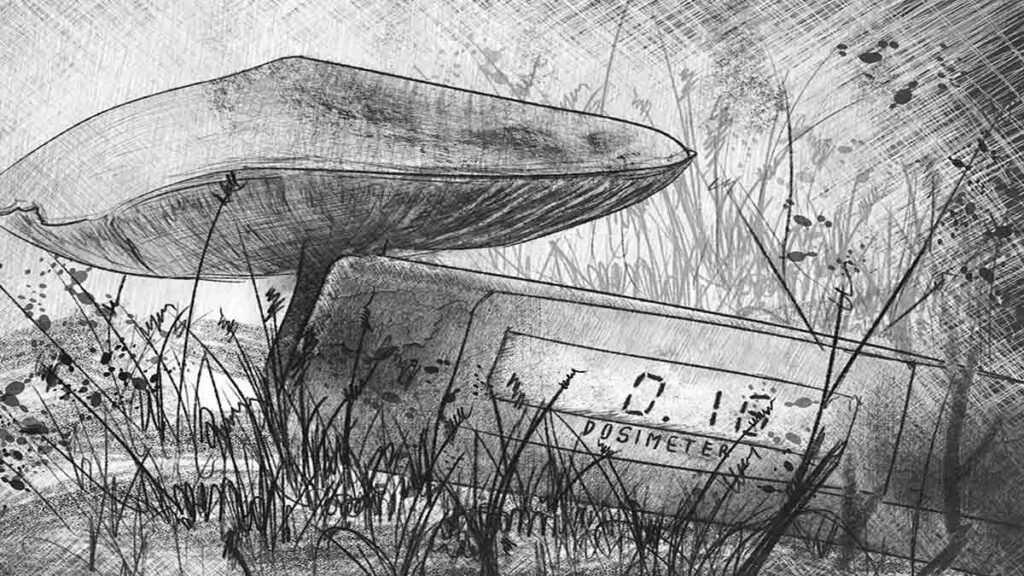
The Chernobyl accident led to powerful radioactive contamination of the ecosystem near Chernobyl. About 200 hectares of luxurious coniferous forest were the most affected, which took a crushing blow, which escaped outside the radiation. Pine was the main monocultural plantation, which, like a warm fur coat, enveloped the entire territory around the Chernobyl nuclear power plant.
It took over first the ominous stream of radiation exposure that hit the flora and fauna as a result of the accident at the nuclear power plant. In a matter of minutes, the rich green fur coat acquired a red-orange shade, consequently, the territory of the entire affected forest was named red or rusty forest.
It is also sad that the main load went to the trees that were in the so-called period of activation of growth processes. This is the time when a young plant is developing intensively and its radiosensitivity, when compared with other growth periods, is almost tripled. The crown of the pine is quite dense, it represents a natural and quite effective filtration protection for wood.
But in this case, it became a fatal factor for the tree. The pine tree does not lose its powerful bark for about three years, like the rest of the group of deciduous trees. That is why, radioactive dust trapped in the grip of a thick pine bark, biting into a tree, inexorably destroys it.
The red forest had a different degree of damage depending on the intensity of the received dose of radiation exposure. Scientists subsequently identified its four characteristic zones:
- the first is a zone of complete destruction of the forest,
- the second is the sublethal area,
- the third is the zone of medium damage,
- the fourth is a zone of weak defeat.
The first zone
This is the territory of the total death of all conifers and partial damage to individual species of deciduous trees – the most characteristic installation of a rusty forest. The dose of radiation exposure absorbed by trees is 500 mR / hour or more. The huge degree of radiation absorbed by these trees led to the fact that at night they emitted a terrifying glow – the result of the interaction of tree enzymes with particles of radioactive products.
The area of the first zone is approximately 4.5 thousand hectares. It took only a couple of days for this part of the forest, eaten from the inside by radiation, to burn completely. The wood of ginger pines emitted a critically strong dose of pollution even in a dead state. Therefore, it was decided to demolish these areas of the forest with bulldozers for the purpose of their subsequent burial.
Over the years, when the radiation background began to decrease significantly, measures were taken to gradually restore and reanimate the ecosystem of the exclusion zone, primarily forest plantations, in this territory.
The second zone
This is the territory of sublethal damage to the forest – the forest loss is from 25 to 40% of trees, the affected area is about 13 thousand hectares. All young shoots and buds became extinct here on pines and deciduous trees. Tremendous damage has been done to the forest undergrowth. Saplings, up to half a meter high, died completely. The dose of radiation absorbed by trees is more than 250 mR / h.
The third zone
This zone is characterized by a moderate severity of damage to the forest. Mainly young shoots were affected on its territory. Yellowed shades of needles were observed only in a few areas or on individual tree branches.
Changes in plant morphology were also visible, in particular, deviations in growth. But in general, the trees in the third zone retained their viability and stability. The dose of radiation exposure absorbed by trees in this area did not exceed 200 mR / h, the territory of the zone is 43.3 thousand hectares.
The fourth zone
This is the entire remaining territory of the Chernobyl forest, where only individual deviations or insignificant anomalies were observed in the process of growth and development of trees. No apparent visible damage to the pines was recorded here. Almost all pine trees retained their genetic qualities: normal growth and natural color of needles. The dose of radiation absorbed by trees in the remaining territory is not more than 20 mR / hour.
The first results of natural processes of natural restoration of flora and fauna of the exclusion zone began to be observed a few years after the Chernobyl accident. It cannot be said unequivocally that the timely burial of the remains of the red forest, carried out as part of the liquidation measures, contributed to this. After all, radioactive wood was immersed for burial in trenches with a depth of only one and a half, maximum two meters.
And this is the level of occurrence of groundwater that turned out to be contaminated with radioactive substances. To fix this problem today is no longer possible. According to scientists, the presence of radionuclides in the groundwater around the burial of a rusty forest remains quite high.
The chain of the cycle of metabolic processes of nature has closed. Today, every pupil will say that, given the negative processes that were caused by the surface burial of radioactive wood, the issue of protection against the consequences of the Chernobyl accident has not been resolved. Time only delayed its solution in a while, deepening environmental problems.